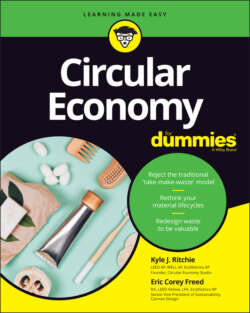Читать книгу Circular Economy For Dummies - Eric Corey Freed - Страница 41
We’re not importing this stuff from space
ОглавлениеEverything you’ve ever bought, everything you’ve ever owned, everything you’ve ever touched, is still here. It’s right here sitting on Planet Earth. If you don’t know where it is, that’s probably because you threw it away. But where is “away”?
“Away” is an imaginary place — or so we humans tell ourselves in order to feel better about all the waste we’ve created. In reality, “away” is probably a landfill somewhere in the world, where your stuff is sitting and waiting while it slowly breaks down over hundreds of years and drips toxic chemicals into the soils and waterways. “Away” doesn’t exist anywhere else.
The only resource we humans get from outside the bounds of Earth is an abundance of free sunlight, coming in from 93 million miles away. No one is making a killer line of shoes made from asteroids. Not a single company is designing handbags made from the soils of Mars. Everything we humans make is made right here from stuff found on Earth, and we’re simply using up everything.
Recently, scientists from the Weizmann Institute of Science in Israel reported that the weight of all the human-made stuff (things we’ve produced) outweighs the weight of all living things on Earth. Apparently, all the buildings, cars, toys, avocado slicers, and every other item we’ve made now weighs more than the remaining life on the planet.
Many of the resources typically extracted are materials that have a finite amount, such as coal, natural gas, oil, sand, iron ore, stone and minerals. As supplies of these resources begin to dwindle, humans have been forced into recycling them, to make new products.
Other natural resources we harvest can be replenished but often aren’t, such as trees, plants, fish, and animals. The demand for these items has increased so much that the source is often destroyed in order to reach them — forests are clear-cut, animals go extinct, or the entire ecosystem is damaged. Humans are just starting to look at sustainable management practices for forests, waterways, fisheries, and habitats.
All this fishing, hunting, gathering, drilling, mining, farming, chopping, excavating, digging, and harvesting has finally brought us to one inescapable conclusion: Earth is the only planet we have, and we have to better manage how we use it.
Scientists estimate that it would take five Planet Earths to support humans if everyone consumed the same as a typical American. Let’s look at two simple examples of US consumption — the typical soda can and the typical plastic bag:
Soda can: That soft drink you’re holding in your hand seems like the perfect container. It’s cool to the touch, easy to open, easily stackable, and easy to hold. But that can is made from aluminum, which is made from mining clay-ore bauxite out of the ground — a nonrenewable resource. Bauxite is typically mined in Australia and Brazil and ships all over the world, where it’s manufactured into aluminum. That process is toxic and produces a significant amount of waste — about five tons for every ton produced. The can has only a 1-in-3 chance of getting recycled. Plus, it’s lined with plastic, which makes it harder to recycle, and that plastic leaches toxic chemicals into the soda you drink. The saddest part: That soda can you're holding had a useful life of only six months from the time it was packaged to the time you drank it.
Plastic bag: That plastic bag the cashier just handed you is made from oil, which means it’s a nonrenewable material and difficult to recycle. It’s one of 500 plastic bags you’ll use this year, and it has a useful life of about ten minutes from the time you leave the store to when you get home and throw it away. Fewer than 10 percent of these bags get recycled, and most end up polluting our waterways instead.
